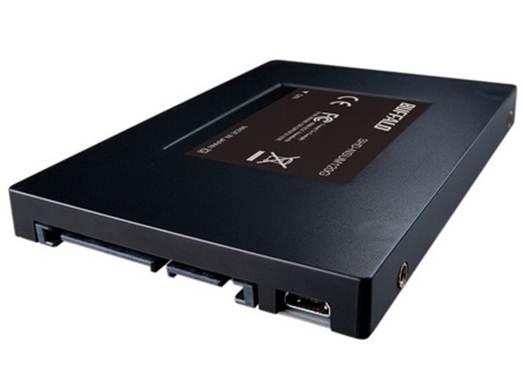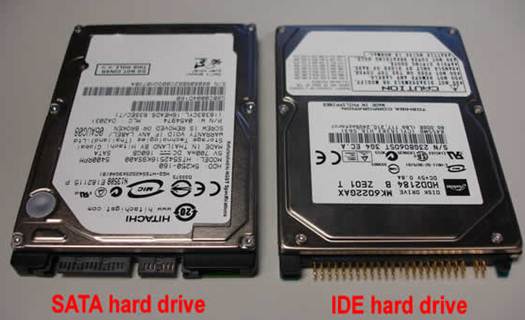What Technology Should You Look For?
Although hard drive specs list huge numbers
of attributes, there are a few main ones to look for, which you can compare
across multiple models for an accurate picture of performance. Capacity is
undoubtedly the main attribute any hard drive buyer looks for, and if you’re
not a particularly informed hard drive buyer, it may even be the only one.
However, it doesn’t tell you anything about how a hard drive performs -
certainly no more than knowing how many seats a car has tells you what its fuel
efficiency and top speed are.

The
current SATA technologies are SATA-2 (or SATA 3G bps) and SATA-3 (or SATA 6G
bps).
The first thing you should pay attention to
after capacity is the connector type. If you have an old motherboard, you may
need to buy an IDE drive, but most recent computers will need a more up-to-date
SATA connection. Don’t worry too much if you buy the wrong one, converters are
available, but if in doubt go for SATA because that way you won’t be limited by
the drive’s connection speed.
The current SATA technologies are SATA-2
(or SATA 3G bps) and SATA-3 (or SATA 6G bps). SATA-3 is twice as fast as
SATA-2, allowing a maximum data throughput of six gigabits a second, so in
theory you should go for hard drives with that sort of connection. However,
it’s not actually that obvious a decision, because mechanical hard drives can’t
physically achieve the kinds of speed it would take to saturate a SATA-2
connection, let alone SATA-3, so the difference ¡s more academic than
practical. If there’s a SATA-2 drive you want and it’s cheaper, don’t be afraid
to buy it.
If you’re interested in getting the best
access speeds out of a drive, a more important statistic is what RPM it can
achieve. RPM refers to the number of revolutions the platters can make per
minute, and the higher this value, the lower the latency between data being
requested, read and delivered. The slowest you’ll see current drives run at is
5400rpm (giving a 5.55 millisecond latency), but the minimum we’d advise
readers to consider is the next step up: 7200rpm (4.l6ms latency). It’s
possible to get drives that run at 10,000rpm (3ms latency) or even 15,000rpm
(2ms latency), but such drives are pushing the realm of specialist equipment
and will undoubtedly cost a premium.
Finally, pay attention to the amount of
cache on a drive. The data cache on hard drives is a temporary storage area
where data can be placed so that the disk does not get delayed waiting for the
physical act of a read/write to happen. The more cache you have, the better
your drive’s performance will be in practical situations.
Mobile drives tend to have a very small
amount of cache (normally 8MB) as a cost-saving measure. Desktop drives
normally have 32MB, but higher-end drives may have 64M B. Be aware that while
more cache is better, it’s hard to quantify the performance of extra cache in
very precise ways, as it will affect operations at speeds that are
imperceptible in isolation.
For that reason, if you’re looking to cut
corners on price, going for a drive with a 32MB cache instead of 64MB cache
will most likely not affect the speed of your computer unless you frequently
run very hard drive intensive tasks such as video-encoding.
Is Now The Right Time To Buy?
Now is probably a better time to buy a hard
drive than at any time in the last 12 months. A series of natural disasters in
2011 dramatically affected the traditional centres of hard drive production in
both economic and practical terms, sending hard drive prices into a huge spike.
They have since almost completely normalised, and they certainly aren’t
expected to drop a significant amount in the near future.
It’s also worth noting that while
solid-state drives perform vastly better than mechanical hard drives, the price
still hasn’t reached the point where they’re a totally viable alternative. They
may be getting more and more popular by the day, but it’ll be a year or two
still before a 500G B SSD drive can be picked up for the amount a 500GB hard
drive currently costs. With that in mind, now is definitely a good time to buy
a mechanical hard drive, because it’s unlikely you’ll be replacing it with a
solid-state drive in the short or medium term.
That said, in all probability any hard
drive you buy in the next 12 months may well end up being the last one you ever
need - so don’t worry too much about the long-term practicality of your choice.
SSD prices are dropping fast, and the longer you wait before buying a hard
drive, the less sense it’ll make to buy one at all.
What Are The Technical Constraints?
As with any internal component, there are
space and power requirements for hard drives. Since you already have a hard
drive in your PC, however, it’s a safe bet you can fit at least one more in.
Most motherboards have two SATA/IDE connectors intended for hard drive usage,
and you should have power supplies for at least two hard drives as well
(although it’s always worth checking).

Most
motherboards have two SATA/IDE connectors intended for hard drive usage
The most likely technical problem you’ll
encounter when using a hard drive is the possibility of a hard drive crash.
While mechanical hard drives aren’t especially unreliable in absolute terms,
they do fail far more than any other component you’re likely to put into your
computer. Luckily, any hard drive with a manufacturing defect will fail pretty
quickly - usually within the first three months of use - so we recommend you
keep your original drive running or stored in a safe place for at least that
long. If your disk survives this initial period, you can be fairly certain of a
year or two of completely error-free use before the drive enters the ‘wear-out’
phase, at which point the risk of failure will steadily increase in line with
the drive’s age.
Despite this, all you need to do to
maintain your drive is leave it alone (physically speaking) and run an
occasional disk check, replacing it as soon as bad sectors begin to appear. mm